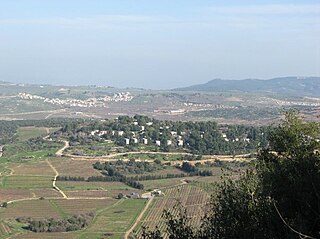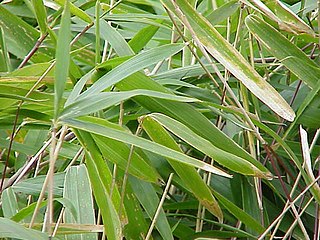
Pseudosasa is a genus of East Asian bamboo in the grass family.

Sasa or Sassa is a kibbutz in the Upper Galilee area of northern Israel. Located one mile from the border with Lebanon, it falls under the jurisdiction of Upper Galilee Regional Council. In 2019 it had a population of 416.

Arundinarieae is a tribe of bamboo in the grass family (Poaceae) containing a single subtribe, Arundinariinae, and 31 genera. These woody bamboos occur in areas with warm temperate climates in southeastern North America, Subsaharan Africa, South Asia and East Asia. The tribe forms a lineage independent of the tropical woody bamboos (Bambuseae) and the tropical herbaceous bamboos (Olyreae).

Acidosasa is a genus of East Asian bamboo in the grass family.

Sasa, also called broad-leaf bamboo, is a genus of running bamboo. These species have at most one branch per node.

Cucurbita palmata is a species of flowering plant in the squash family known by the common names coyote melon and coyote gourd. It is similar to Cucurbita californica, Cucurbita cordata, Cucurbita cylindrata, and Cucurbita digitata and all these species hybridize readily. It was first identified by Sereno Watson in 1876. These species form the only restricted xerophyte species group in the genus Cucurbita. Each member of this species group is native to the Southwestern United States and Northwestern Mexico where they are relatively uncommon. Each group member is found in hot, arid regions with low rainfall. They prefer soil that is loose, gravelly, and well-drained. C. palmata is native to northeastern Baja California, southeastern California, and southwestern Arizona to a point near the Colorado River. The juvenile leaves of C. cylindrata, C. cordata, C. digitata, and C. palmata show a high degree of similarity, but their mature leaves are visibly different, as are their root structures. C. palmata and C. digitata are sympatric, with C. palmata separating the ranges of C. digitata at the juncture of Baja California, California, and Arizona. C. palmata fruits are diffuse green mottle that turns yellow at maturity, striped, and round.

Amuka is a community settlement near Safed in the Upper Galilee in northern Israel. It belongs to the Merom HaGalil Regional Council. It is named for the Biblical city of the same name, which is presumed to be located near the present-day settlement. In 2019 it had a population of 132.

The Bambouseraie de Prafrance is a private botanical garden specializing in bamboos, located in Générargues, near Anduze, Gard, Languedoc-Roussillon, France. It is open daily in the warmer months; an admission fee is charged.

Lethe diana, the Diana treebrown, is a brush-footed butterfly in the family Nymphalidae. Its wings are a dark shade of brown, with an eyespot pattern, and a wingspan of about 45–55 mm. It resembles Lethe confusa; however, the Lethe confusa bears a white band on its wings, setting them apart.

Vitis palmata is a New World species of tall, climbing liana in the grape family native to the south-central and southeastern parts of the United States, from Texas east to Florida and northwards along the Mississippi Valley to Illinois. There are additional reports of isolated populations in the Northeast, but these are probably introductions.) The species does best in wet habitats but is adaptable enough to occasionally take root in higher-ground habitats. It is sometimes found at the edges of fences.
Sasamorpha is a genus of East Asian bamboo in the grass family.
- Sasamorpha borealis(Hack.) Nakai – Korea, Japan, Sakhalin
- Sasamorpha hubeiensisC.H.Hu – Hubei, Jiangxi
- Sasamorpha oshidensis(Makino & Uchida) Nakai – Japan
- Sasamorpha qingyuanensisC.H.Hu – Zhejiang
- Sasamorpha sinica(Keng) Koidz. – Anhui, Zhejiang

× Phyllosasa is a nothogenus of Japanese bamboo in the grass family.

Mount Naka Katsuragi is a mountain in the Kongō Range to the south of Mount Kongō, rising to an elevation of 937.7 metres (3,076 ft). The mountain is situated between Chihayaakasaka, Osaka and Gojō, Nara in Japan. It is known for its trails being generally easy for most hikers, and for its stands of Japanese cedar and large fields of bamboo grass.
Streptomyces gramineus is a bacterium species from the genus of Streptomyces which has been isolated from the rhizosphere soil of the plant Sasa borealis.
Streptomyces graminifolii is a bacterium species from the genus of Streptomyces which has been isolated from the plant Sasa borealis.
Streptomyces graminisoli is a bacterium species from the genus of Streptomyces which has been isolated together with Streptomyces rhizophilus from rhizosphere soil from the plant Sasa borealis.
Streptomyces rhizophilus is a bacterium species from the genus of Streptomyces which has been isolated from rhizosphere soil from the plant Sasa borealis.

Nipa palm vinegar, also known as sukang sasa or sukang nipa, is a traditional Filipino vinegar made from the sap of the nipa palm. It is one of the four main types of vinegars in the Philippines, along with coconut vinegar, cane vinegar, and kaong palm vinegar. It is usually sold under the generic label of "palm vinegar".

Sasa veitchii is a species of flowering plant in the genus Sasa, in the Poaceae family.














